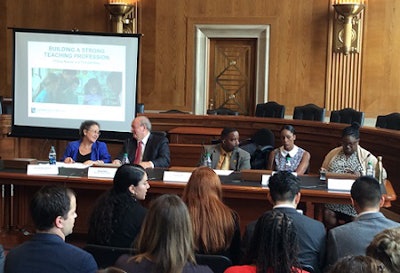
WASHINGTON – While some changes have been proposed, more must be made to address a teacher shortage that is affecting K-12 education across the nation, particularly for low-income and Black students.
Strategies to address increasing the ranks of teachers in higher education and other pipeline problems were discussed Tuesday by panelists at a briefing organized by the Learning Policy Institute (LPI) at the Senate Dirksen Office Building.
While demand for teachers has been increasing, supply has been decreasing. The majority of states, in some cases more than 80 percent, report severe teacher shortages in key areas such as special education, math and science, with the shortage even greater in schools that serve lower-income students, Sen. Tim Kaine, D-Va., said in brief remarks to about 100 guests attending “Strengthening the Educator Pipeline: Evidence-Based Approaches to Teacher and Leader Preparation.”
And amid the browning of America and its public schools, teachers of color are underrepresented as only about 20 percent of the workforce, with the percentage of Black teachers declining to just 6.7 percent in 2013, Kaine said.
Such critical issues, he added, must be addressed when the Higher Education Act (HEA) of 1965 is again reviewed for reauthorization. The Preparing and Training Education Professional (PREP) Act proposes to make changes to HEA to improve the effectiveness of grant programs by building teacher and leader capacity to create student-centered, inclusive and supportive learning environments at the elementary and secondary levels. The legislation aims to enhance cultivation of a diverse and highly prepared educator workforce that recruits, equips and supports teachers in high-need fields at high-need locations.
Among proposed key changes that could help underserved students and strengthen the connections between secondary and post-secondary institutions are:















